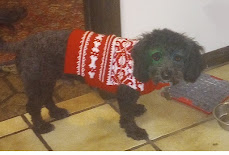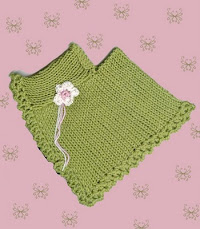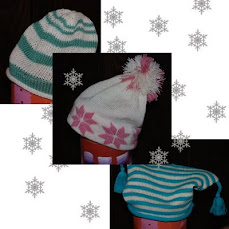I got this idea from my friend, Sandy, who is a fantastic knitter and is very creative as well as practical. You can see her web page at http://slisen.blogspot.com/
I'm on my second to the last charity item for the year and decided to knit one of Charlene Schafer's tuck baby blankets. All turned out well except the edges curled more than I liked. Enter Sandy's fix. She folds and bastes the edges together with a contrasting color yarn. Then she puts the blanket in the washing machine for a fairly gentle cycle and also in the dryer for a bit (not drying the blanket all the way.) She lets the blanket air dry the rest of the way with the basting still in place. Voila', the edges behave. She says if you have some really stubborn edges, she refolds the opposite direction, bastes and repeats the wash/dry process.
Here are my before and after pics. I guess I should have taken a pic of the curling edges, not just the edges basted.
When dry:
Worked like a charm. Next time you have that problem with the curling edges, try Sandy's trick. It only takes about 10 minutes more to do the basting.
PS She said she usually does a running stitch as close to the edge as possible (rather than the kind of basting I did), but it appears that it doesn't matter when all is said and done.
machine knitting midgauge standard bulky machknit knit machine-knit patterns
Monday, July 29, 2013
Monday, July 15, 2013
A beautiful first time machine knit garment
Lynne, one of my readers, has knit her first garment on her LK 150 using the Baby Ballet pattern. Isn't it beautiful?
I love the yarn colors. Here's what she had to say about it:
I love the yarn colors. Here's what she had to say about it:
Well after a lot of trial and error I have completed the ballerina
cardigan - see photo attached. My very first machine knitted garment! I
followed most of your pattern except that when it came to binding off for the
sleeves once they were attached to the body, I used the back stitch bind off as
it was too tight doing the bind off with the latch tool.
I had to redo a lot of things but am pleased with the result. I
only used one ball of yarn and am wondering if you have a machine pattern for
baby leggings that I can make to match the sweater?
I'd say she did a fantastic job. One of the frustrations, if you want to call it that, of the plastic bed machines is that they have no gate pegs. So, it's a little more complicated binding off around the gate pegs. Do-able when you use a machine needle as a substitute for a gate peg, but might be cumbersome for a new knitter. Definitely something to learn at some point, though. If you do want to use the latch tool to pull the next stitch through the previous to bind off--- one trick is to hand knit the last row and pull the needle butt all the way back to make a large stitch. Then when you pull the next stitch through the one on the latch tool, it should be the right size and not pull in.
Does anyone have a pattern for baby leggings? Would be nice to help her out.
Would love to see any other Baby Ballets that have been knit from this pattern.
Friday, July 12, 2013
Very Beginner Level Machine Knit Baby Ballet Sweater
I have two friends who are just starting out knitting on midgauge machines so I thought I'd post a baby sweater pattern that is an excellent learning pattern when just starting out. It's not complicated and can be completed in short order, but the result is really cute. There are 4 sizes to the pattern. Since it goes so quickly, you can knit a bunch for charity and improve your skills as you go.
Baby Ballet Sweater on the Midgauge
Machine by Mar
Heck Revised May, 2014
 |
This is the perfect first baby sweater for a
new machine knitter. You don’t have to
worry about ribbing on the bottom or cuffs.
You don’t have to learn how to short-row yet, which is usually how the
neck is done. You do learn a few basic
tricks, like decreasing, hanging shoulders, picking up stitches and making I
cords. Hint---use waste yarn that is a
totally different color than your main yarn so you can see what to pick up.
YARN:
Any yarn that knits to gauge below.
Size doesn’t matter too much if you are making this for charity. If knitting for a present, you could knit one
and determine if that’s the size you want and going from there, knit another
since they go fast. Use whatever yarn
knits nice and easy on your machine.
Notes:
· You will do the bottom edges of the fronts, back and sleeves at a
tighter tension on the tension dial for 4 rows than you do the body of the
sweater so the roll hem is tighter.
· Four I cord ties are attached to both sides to keep the sweater in
place.
· Notice on the yellow sweater pictured at the end of the pattern, I
did the front ties a couple of inches in for a chubbier baby, or just a
different look.
· The sweater consists of 5 pieces plus four I cords.
· You can skip the waste yarn
and ravel cord to start each piece to save some time. Ewrap on the required needles and every row
for a few rows, pull all the needles to E position before you knit the row. Remember to follow the pattern, though. When you have enough knitting, you can hang
some claw weights. If you are not
comfortable doing this, start with waste yarn and ravel cord.
FINISHED SIZES
6 (12, 18, 24) months Circle the number you
need throughout the pattern.
GAUGE 5 st and 6 r = 1” (20 st and 24 r = 4”) It’s a good idea to do
a gauge swatch first to get the same gauge as the pattern. If you have fewer stitches and rows to the
inch, tighten your tension for the main pieces.
If you have too many stitches and rows to the inch, loosen your tension
for the main pieces.
BACK
T3 Over 50(52, 56, 58) st cast on with waste yarn, knit a few rows, one row ravel cord. E wrap with main yarn right on top of the ravel cord stitches. RC 000, T 3, Knit 4 rows. Change to T 6 (main tension). RC000. Knit to RC 60 (64,66,72). Take off stitches in 3 parts.
T3 Over 50(52, 56, 58) st cast on with waste yarn, knit a few rows, one row ravel cord. E wrap with main yarn right on top of the ravel cord stitches. RC 000, T 3, Knit 4 rows. Change to T 6 (main tension). RC000. Knit to RC 60 (64,66,72). Take off stitches in 3 parts.
First size:
17 shoulder st on WY, 16 neck bind off, 17 shoulder on WY
Second size:
18 shoulder on WY, 16 neck Bind off, 18 shoulder on WY
Third size: 19 shoulder on WY, 18 neck bind
off, 19 shoulder on WY
Fourth size:
20 shoulder on WY, 18 neck bind off, 20 shoulder on WY
To take off in sections, put all but specified shoulder stitches/ needles on the right in
hold, meaning all the way out towards you.
Set the carriage levers both sides to H (or consult your manual). When you knit, only the first stitches will knit and the carriage will
slide over the others. As you knit to
the left, pull up on the yarn so that it doesn’t get caught under the
carriage. Knit 10 rows of waste yarn and
remove these stitches by running the carriage with no yarn in it. When done with the first shoulder, bind off
the specified number of neck stitches with a back stitch bind off by hand (OR
ANY BIND OFF YOU CHOOSE). Remove these
st from machine. You’ll have hanging
down the first shoulder on its waste yarn and the bound off neck stitches
hanging down. Now take your machine off
hold so that the final section of stitches knit. Knit 10 rows of waste yarn and one row with
no yarn to remove from machine.
LEFT AND RIGHT FRONT AND NECK SHAPING—Do the decreases on one side for one
front and on the other side for the other front.
T3 over 50 (52,56,58) st cast on with waste yarn, knit a few rows, one row ravel cord. Ewrap with main yarn. T 3 Knit 4 rows. Change to T6 (main tension).RC 000. Decrease for Neck shaping on one side of your knitting as follows:
T3 over 50 (52,56,58) st cast on with waste yarn, knit a few rows, one row ravel cord. Ewrap with main yarn. T 3 Knit 4 rows. Change to T6 (main tension).RC 000. Decrease for Neck shaping on one side of your knitting as follows:
First size:
Example – On RC 3, decrease one stitch every
two rows two times, meaning do the decrease on RC 3 and RC 5. You can write in the in between row numbers
if it helps keep track.
Second Size:
Third size:
Fourth size;
Do a full fashioned decrease this
way: Move 4th stitch to 3rd
stitch so there are 2 st on that needle, then move the 3 stitches in toward the
center with your 3 prong tool. Put the
empty N out of work. This makes a dandy
edge that doesn’t curl much.
Take shoulder st off on waste yarn the same way
you did the back shoulders. Knit the other
front, decreasing on the opposite side.
SLEEVES
T 3, over 30 (32,36,40) sts Cast on with waste yarn, knit a few rows, one row ravel cord. E wrap with main yarn. Knit 4 rows. Change to T 6. RC 000.
T 3, over 30 (32,36,40) sts Cast on with waste yarn, knit a few rows, one row ravel cord. E wrap with main yarn. Knit 4 rows. Change to T 6. RC 000.
First size:
Increase one stitch both sides every 3 rows 8x (46st). Knit to RC 30.
Second size:
Increase one stitch both sides every 3 rows 8x (48 st). Knit to RC36.
Third size: Increase one stitch both sides every 4 rows 7X
(50 st).Knit to RC 40.
Fourth size:
Increase one stitch both sides every 5 rows 7x (54 st). Knit to RC 42.
To do full fashioned increase, move 3 st
out one and pick up the purl bump at n to the center and hang on empty needle.
When you reach the required number of rows, Take the sleeve off on a
few rows of waste yarn without binding off.
(No need for ravel cord at the top.)
FINISHING
Seam shoulders- With the right side of the sweater facing you, fold waste yarn so the purl bumps are easy to see. Hang one back shoulder with right side facing you. Push to back of the bed. Hang matching front shoulder, wrong side facing you, into the hooks of the needles. Close the latches with your straight edge. With a straight edge push front through back stitches in one fell swoop. Check to make sure all stitches got pushed thru. Carefully push all the N all the way out with a straight edge in one hand and push knitting to the back of the bed with the other hand. With main yarn, main tension, knit one row from left to right. Bind off. Repeat for other shoulder. Remove waste yarn at shoulders.
Seam shoulders- With the right side of the sweater facing you, fold waste yarn so the purl bumps are easy to see. Hang one back shoulder with right side facing you. Push to back of the bed. Hang matching front shoulder, wrong side facing you, into the hooks of the needles. Close the latches with your straight edge. With a straight edge push front through back stitches in one fell swoop. Check to make sure all stitches got pushed thru. Carefully push all the N all the way out with a straight edge in one hand and push knitting to the back of the bed with the other hand. With main yarn, main tension, knit one row from left to right. Bind off. Repeat for other shoulder. Remove waste yarn at shoulders.
Sew Sleeves to body- Hang side of body with
right side facing you. When you use a 3
prong tool, the stitches are spaced about right. Shoulder seam at zero and 23 (24, 25, 27)
stitches both sides of zero. Hang one
stitch in---in the same ditch all along so it looks perfect on the right side. Measure
to make sure you have hung the same amount both sides. Adjust if you need to. Push
to back of the bed, open the latches.
With the wrong side of the sleeve facing you, hang the 46(48, 50, 54)
sleeve stitches in the hooks of the needles.
Close the latches. Take a ruler
or your long weight bar or your cast on comb and push these front stitches through
the back stitches. (It needs to be at least as wide as your knitting.) Knit one
row and bind off. Remove the rest of the
waste yarn
Seam sides and sleeves with a mattress stitch
by hand. Weave in yarn ends
TIES (4 of them) Pick up
3 stitches at the corners and side seams, one at a time. Row counter to zero. Do a 3 stitch I cord at T 3 for 100 rows or
about 5-6 inches. Bind off by putting the left and right stitch on the center needle. Cut the yarn at 3” and pull through the last
stitch 2 X. Hide yarn end into the I
cord. Do the same on the other corner and each seam.
I cord is short for “idiot cord”. Some people call it a slip
cord because the carriage slips over the stitches when going one
direction. To make, push 3 needles all
the way out. ewrap on those 3 needles. All the others are out of work. Put the lever on one side of the carriage to
“Part”. (Consult your manual.) This means that when the carriage goes one
way it knits and when it comes back the other way, it skips over the
needles. After a few rows, it starts to
make a tube. The needles go back to B
position (working position) as you knit the first row. Rather than weighting the I cord, you can
hang on to the end with your left hand and run the carriage with your right
hand.
Optional Embroidery – With yarn doubled, make a
bunch of lazy daisy daisies down the fronts and on the sleeves. Use a contrast color or same as main yarn.
Steam the sweater if you want. Careful
so you don’t melt the acrylic. The acrylic yarn should wash and dry nicely.
ABBREVIATIONS
WY waste yarn
BO bind off
N needle(s)
ST stitch(es)
CO cast on
RC row counter
T with number is the number to set the tension dial at. EX: T6 is tension 6 on the dial
Dec decrease
Incr increase
H holding position
This is a learning pattern for classes at the MKGM. You can donate, gift or sell items made from
this pattern, but please don’t claim the pattern as your own. Thanks!
Subscribe to:
Comments (Atom)













































































